ATTRACTIONS
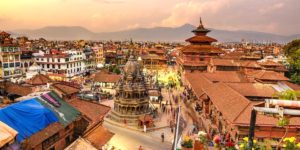 Kathmandu also known as City of Temples, is the capital city and largest city of Nepal with a population of around 1 million. The city was the royal capital of the Kingdom of Nepal and hosts palaces, mansions and gardens of the Nepalese aristocracy. Kathmandu is and has been for many years the center of Nepal’s history, art, culture and economy. Tourism is an important part of the economy. Tourism is a major source of income for most of the people in the city, with several hundred thousand visitors annually. Hindu and Buddhist pilgrims from all over the world visit Kathmandu’s religious sites such as Pashupatinath, Swayambhunath, Boudhanath, Changunarayan and Budhanilkantha. The high level of tourism is attributed to the natural grandeur of the Himalayas and the rich cultural heritage of the country. The neighbourhood of Thamel is Kathmandu’s primary “traveller’s ghetto”, packed with guest houses, restaurants, shops, and bookstores, catering to tourists. Another neighbourhood of growing popularity is Jhamel, a name for Jhamsikhel that was coined to rhyme with Thamel. Jhochhen Tol, also known as Freak Street, is Kathmandu’s original traveller’s haunt, made popular by the hippies of the 1960s and 1970s; it remains a popular alternative to Thamel. Asan is a bazaar and ceremonial square on the old trade route to Tibet, and provides a fine example of a traditional neighbourhood. With the opening of the tourist industry after the change in the political scenario of Nepal in 1950, the hotel industry drastically improved. Now Kathmandu boasts several luxurious hotels from 3-star to 5-star hotels providing casinos as well. Kathmandu is also home to a number of museums and art galleries, including the National Museum of Nepal and the Natural History Museum of Nepal. The museums display unique artefacts and paintings from the 5th century CE to the present day, including archaeological exportation.
Kathmandu also known as City of Temples, is the capital city and largest city of Nepal with a population of around 1 million. The city was the royal capital of the Kingdom of Nepal and hosts palaces, mansions and gardens of the Nepalese aristocracy. Kathmandu is and has been for many years the center of Nepal’s history, art, culture and economy. Tourism is an important part of the economy. Tourism is a major source of income for most of the people in the city, with several hundred thousand visitors annually. Hindu and Buddhist pilgrims from all over the world visit Kathmandu’s religious sites such as Pashupatinath, Swayambhunath, Boudhanath, Changunarayan and Budhanilkantha. The high level of tourism is attributed to the natural grandeur of the Himalayas and the rich cultural heritage of the country. The neighbourhood of Thamel is Kathmandu’s primary “traveller’s ghetto”, packed with guest houses, restaurants, shops, and bookstores, catering to tourists. Another neighbourhood of growing popularity is Jhamel, a name for Jhamsikhel that was coined to rhyme with Thamel. Jhochhen Tol, also known as Freak Street, is Kathmandu’s original traveller’s haunt, made popular by the hippies of the 1960s and 1970s; it remains a popular alternative to Thamel. Asan is a bazaar and ceremonial square on the old trade route to Tibet, and provides a fine example of a traditional neighbourhood. With the opening of the tourist industry after the change in the political scenario of Nepal in 1950, the hotel industry drastically improved. Now Kathmandu boasts several luxurious hotels from 3-star to 5-star hotels providing casinos as well. Kathmandu is also home to a number of museums and art galleries, including the National Museum of Nepal and the Natural History Museum of Nepal. The museums display unique artefacts and paintings from the 5th century CE to the present day, including archaeological exportation.
 Mount Everest is the Earth’s highest mountain. The international border between Nepal and China runs across its summit point. Because Mount Everest is the highest mountain in the world, it has attracted considerable attention and climbing attempts to make it to the top, some of climbers are highly trained professionals and experienced mountaineers. Everest remained a difficult climb for decades, although lower mountains have longer or steeper climbs, Everest is so high the jet stream can hit it. Climbers are in danger of altitude sickness, weather, and wind, as well as significant hazards from avalanches and the Khumbu Icefall. A set of climbing routes has been established over several decades of climbing expeditions to the mountain, the two main climbing routes are the southeast ridge from Nepal and the north ridge from Tibet. Of the two main routes, the southeast ridge is technically easier and more frequently used. The routes usually share one spot in common, the summit itself. The summit of Everest has been described as “the size of a dining room table”. The summit is capped with snow over ice over rock, and the layer of snow varies from year to year. Below the summit there is an area known as “rainbow valley”, filled with dead bodies still wearing brightly colored winter gear. Down to about 8000 meters is an area commonly called the “death zone”, due to the high danger and low oxygen because of the low pressure. A 2008 study noted that the “death zone” is indeed where most Everest deaths occur. Whether the mountain was climbed in ancient times is unknown. It may have been climbed in 1924. Everest’s first known summit occurred by 1953, and interest by climbers increased. Everest can be climbed without supplementary oxygen, but only by the most accomplished mountaineers and at increased risk. For foreign travelers, Everest Base Camp has become one of the most popular trekking destinations in Tibet, offering the chance to gaze on the magnificent north face of the world’s highest peak – Mount Everest. It has become many brave people’s dreams to demonstrate their courage and skills by climbing onto this world’s highest peak. Mount Everest has been host to other winter sports and adventuring besides mountaineering, including snowboarding, skiing, rappelling, hang-gliding, paragliding, and base jumping. Various types of gliding descents have slowly become more popular, and are noted for their rapid descents to lower camps.
Mount Everest is the Earth’s highest mountain. The international border between Nepal and China runs across its summit point. Because Mount Everest is the highest mountain in the world, it has attracted considerable attention and climbing attempts to make it to the top, some of climbers are highly trained professionals and experienced mountaineers. Everest remained a difficult climb for decades, although lower mountains have longer or steeper climbs, Everest is so high the jet stream can hit it. Climbers are in danger of altitude sickness, weather, and wind, as well as significant hazards from avalanches and the Khumbu Icefall. A set of climbing routes has been established over several decades of climbing expeditions to the mountain, the two main climbing routes are the southeast ridge from Nepal and the north ridge from Tibet. Of the two main routes, the southeast ridge is technically easier and more frequently used. The routes usually share one spot in common, the summit itself. The summit of Everest has been described as “the size of a dining room table”. The summit is capped with snow over ice over rock, and the layer of snow varies from year to year. Below the summit there is an area known as “rainbow valley”, filled with dead bodies still wearing brightly colored winter gear. Down to about 8000 meters is an area commonly called the “death zone”, due to the high danger and low oxygen because of the low pressure. A 2008 study noted that the “death zone” is indeed where most Everest deaths occur. Whether the mountain was climbed in ancient times is unknown. It may have been climbed in 1924. Everest’s first known summit occurred by 1953, and interest by climbers increased. Everest can be climbed without supplementary oxygen, but only by the most accomplished mountaineers and at increased risk. For foreign travelers, Everest Base Camp has become one of the most popular trekking destinations in Tibet, offering the chance to gaze on the magnificent north face of the world’s highest peak – Mount Everest. It has become many brave people’s dreams to demonstrate their courage and skills by climbing onto this world’s highest peak. Mount Everest has been host to other winter sports and adventuring besides mountaineering, including snowboarding, skiing, rappelling, hang-gliding, paragliding, and base jumping. Various types of gliding descents have slowly become more popular, and are noted for their rapid descents to lower camps.
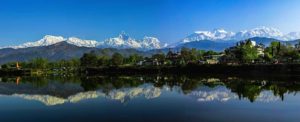 Pokhara Pokhara is the second largest city in Nepal. Pokhara is the tourism capital of Nepal, being a base for trekkers undertaking the Annapurna Circuit through the Annapurna Conservation Area region of the Annapurna ranges in the Himalayas. Pokhara is known to be a popular tourist destination for visitors from all over the world. Every year, many people visit the location in order to travel to the Annapurna range and famous religious place muktinath. The area along the Phewa lake, called Lake Side, has developed into one of the major tourism hubs of Nepal. The tourist district is along the north shore of the Phewa lake (Baidam, Lakeside and Damside). It is mainly made up of small shops, non-star tourist hotels, restaurants and bars. Most upscale and starred hotels are on the southern shore of the Phewa Lake and southeastern fringes of the city where there are more open lands and unhindered view of the surrounding mountains. To the east of the Pokhara valley, in Lekhnath municipality, there are seven smaller lakes such as Begnas Lake, Rupa Lake, Khaste lake, Maidi lake, Neureni lake, Dipang lake. Begnas Lake is known for its fishery projects. After the first road was completed in 1968, tourism set in and Pokhara grew rapidly, and became the major tourism Hub in Nepal.
Pokhara Pokhara is the second largest city in Nepal. Pokhara is the tourism capital of Nepal, being a base for trekkers undertaking the Annapurna Circuit through the Annapurna Conservation Area region of the Annapurna ranges in the Himalayas. Pokhara is known to be a popular tourist destination for visitors from all over the world. Every year, many people visit the location in order to travel to the Annapurna range and famous religious place muktinath. The area along the Phewa lake, called Lake Side, has developed into one of the major tourism hubs of Nepal. The tourist district is along the north shore of the Phewa lake (Baidam, Lakeside and Damside). It is mainly made up of small shops, non-star tourist hotels, restaurants and bars. Most upscale and starred hotels are on the southern shore of the Phewa Lake and southeastern fringes of the city where there are more open lands and unhindered view of the surrounding mountains. To the east of the Pokhara valley, in Lekhnath municipality, there are seven smaller lakes such as Begnas Lake, Rupa Lake, Khaste lake, Maidi lake, Neureni lake, Dipang lake. Begnas Lake is known for its fishery projects. After the first road was completed in 1968, tourism set in and Pokhara grew rapidly, and became the major tourism Hub in Nepal.
TRAVEL ADVENTURE
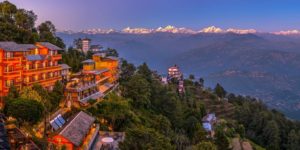 The high level of tourism of Nepal is attributed to the natural grandeur of the Himalayas and the rich cultural heritage of the country. Situated in a strategic location, Nagarkot was an ancient fort of the Kathmandu valley built to monitor the external activities of other kingdoms. Later, it became a summer retreat for the royal family before becoming popular as an international hill station. At an elevation of 2,195 meters, it is considered one of the most scenic spots in Bhaktapur District. It is known for a sunrise view of the Himalayas including Mount Everest as well as other peaks of the Himalayan range of eastern Nepal. Nagarkot also offers a panoramic view of the Kathmandu Valley. The scenic beauty of the place makes it a very popular hiking route for tourists. Nagarkot commands one of the broadest views of the Himalayas in the Kathmandu valley and Shivapuri National Park. For those active nature lovers and outdoor enthusiasts, there are lots of hiking opportunities to do in and around Nagarkot. Among them, Nagarkot Eco Trail along with Nagarkot Panoramic Hiking Trail is the most popular ones. You can also do paragliding with Everest view in Nagarkot. The place is perfect for travelers who want to experience the beauty and majesty of the Himalayas without arduous physical activity.
The high level of tourism of Nepal is attributed to the natural grandeur of the Himalayas and the rich cultural heritage of the country. Situated in a strategic location, Nagarkot was an ancient fort of the Kathmandu valley built to monitor the external activities of other kingdoms. Later, it became a summer retreat for the royal family before becoming popular as an international hill station. At an elevation of 2,195 meters, it is considered one of the most scenic spots in Bhaktapur District. It is known for a sunrise view of the Himalayas including Mount Everest as well as other peaks of the Himalayan range of eastern Nepal. Nagarkot also offers a panoramic view of the Kathmandu Valley. The scenic beauty of the place makes it a very popular hiking route for tourists. Nagarkot commands one of the broadest views of the Himalayas in the Kathmandu valley and Shivapuri National Park. For those active nature lovers and outdoor enthusiasts, there are lots of hiking opportunities to do in and around Nagarkot. Among them, Nagarkot Eco Trail along with Nagarkot Panoramic Hiking Trail is the most popular ones. You can also do paragliding with Everest view in Nagarkot. The place is perfect for travelers who want to experience the beauty and majesty of the Himalayas without arduous physical activity.
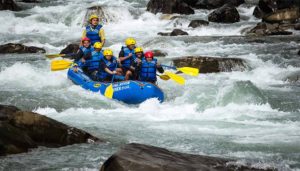 The Bhote Koshi is the upper river course of the Sun Kosi river in Tibet. It is part of the Koshi River system in Nepal. The Bhote Kosi is used for both rafting and kayaking perfect for individuals who are looking to take a break from sightseeing and trekking in Nepal and indulge in some adrenalin pumping adventure. It is the steepest river rafted in Nepal, with a gradient of 15 m per km. Bungee jumping or swinging over the Bhote Kosi has been described as the ‘ultimate experience’. Despite the nature of the sport, the bungee is very safe. It is the highest free fall in the world. The river is steep and continuous with one rapid leading into another. It is one of the best rafting trips in the world with continuous big volume and steep whitewater rapids.
The Bhote Koshi is the upper river course of the Sun Kosi river in Tibet. It is part of the Koshi River system in Nepal. The Bhote Kosi is used for both rafting and kayaking perfect for individuals who are looking to take a break from sightseeing and trekking in Nepal and indulge in some adrenalin pumping adventure. It is the steepest river rafted in Nepal, with a gradient of 15 m per km. Bungee jumping or swinging over the Bhote Kosi has been described as the ‘ultimate experience’. Despite the nature of the sport, the bungee is very safe. It is the highest free fall in the world. The river is steep and continuous with one rapid leading into another. It is one of the best rafting trips in the world with continuous big volume and steep whitewater rapids.
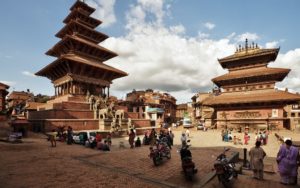 One of the temples that are still in existence today is the Nyatapola Temple, which was built in 1702 A.D. under the rule of King Bhupatindra Malla. This beautifully sculptured building is considered one of the tallest pagodas in the country and is a lovely example of the immense workmanship that went into buildings of this type. This five-storey temple with a five-tier roof that stands just over thirty meters high can be reached by walking up a flight of steps that leads to the top of the platform. As you walk up these terraces you will notice that there are stone figures of the temple guardians on either side of you on every step. The Nyatapola temple was built and dedicated to the goddess Siddhi Lakshmi or Siddhi Laxmi, providing the Nepalese with a place to worship her. The temple rests on a base of five levels with four Ganesh shrines in each of the corners. The buildings structure is so sturdy that it withstood an 8.3 earthquake in 1934, followed by another in 2015, without any significant architectural damage.
One of the temples that are still in existence today is the Nyatapola Temple, which was built in 1702 A.D. under the rule of King Bhupatindra Malla. This beautifully sculptured building is considered one of the tallest pagodas in the country and is a lovely example of the immense workmanship that went into buildings of this type. This five-storey temple with a five-tier roof that stands just over thirty meters high can be reached by walking up a flight of steps that leads to the top of the platform. As you walk up these terraces you will notice that there are stone figures of the temple guardians on either side of you on every step. The Nyatapola temple was built and dedicated to the goddess Siddhi Lakshmi or Siddhi Laxmi, providing the Nepalese with a place to worship her. The temple rests on a base of five levels with four Ganesh shrines in each of the corners. The buildings structure is so sturdy that it withstood an 8.3 earthquake in 1934, followed by another in 2015, without any significant architectural damage.
THE PEOPLE
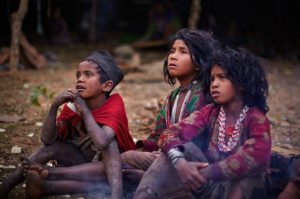 The people of Nepal are called Nepalis they are of many different national and ethnic origins. As a result, people of Nepal do not equate their nationality with ethnicity, but with citizenship and allegiance.
The people of Nepal are called Nepalis they are of many different national and ethnic origins. As a result, people of Nepal do not equate their nationality with ethnicity, but with citizenship and allegiance.
The cultural heritage of Nepal has evolved over the centuries. This multi-dimensional heritage bounds the diversities of Nepal’s ethnic, tribal, and social groups, and it expresses in music and dance; art and craft; folklore and folktales; languages and literature; philosophy and religion; festivals and celebration; foods and drinks. Its culture is mostly influenced by Indian culture and Tibetan culture. Legends state that dances in Nepal originated in the abode of Lord Shiva – the Himalayas, where he performed the tandava dance. This indicates that dance traditions of Nepal are very ancient and unique. Most festivals include dancing and music, and a variety of special foods are consumed during festivals and on special occasions. Folklore is an integral part of Nepali society. Traditional stories are rooted in the reality of day-to-day life, tales of love, affection and battles as well as demons and ghosts and thus reflect local lifestyles, culture, and beliefs. Many Nepali folktales are enacted through the medium of dance and music.